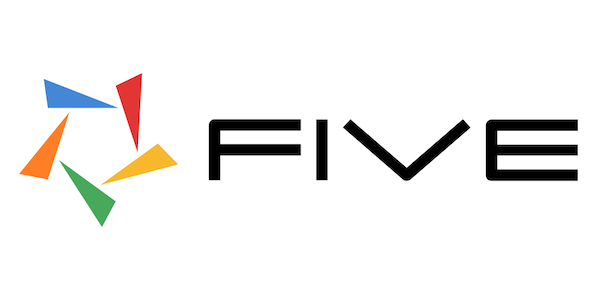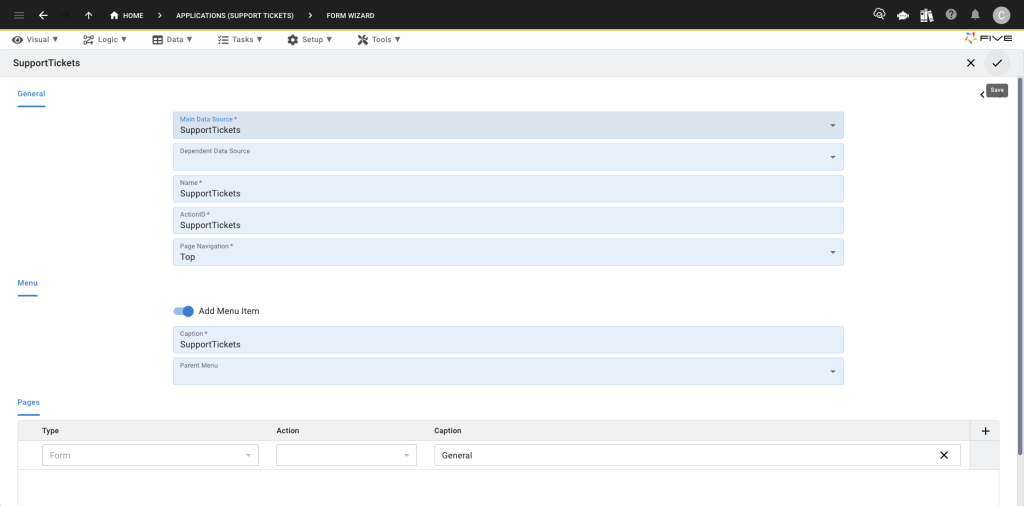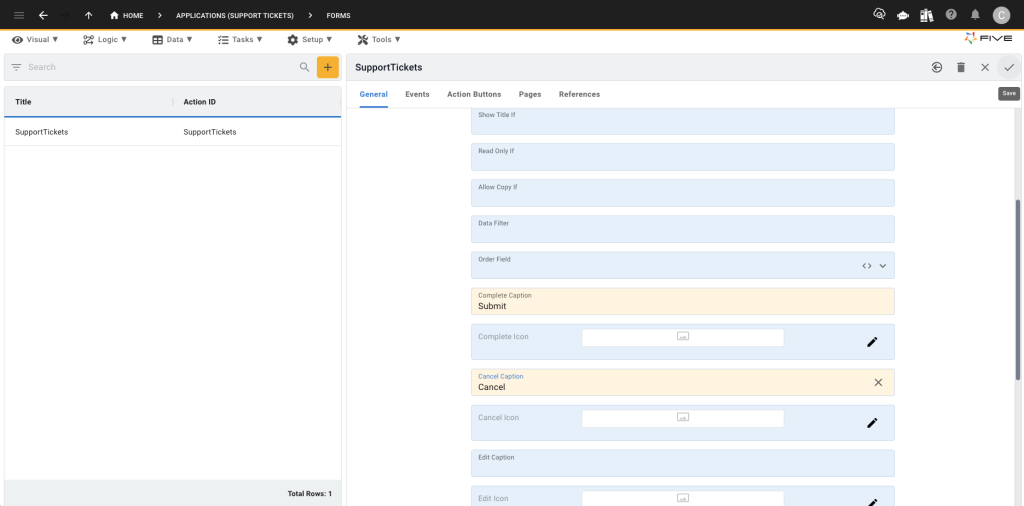Create a Ticketing System in 3 Steps
How to Create a Ticketing System
In this guide, we outline the steps necessary to create and launch a support ticketing system using Five’s advanced form builder.
The process involves:
- Creating the database
- Designing the form
- Deploying the form
We will also cover securing the form with logins, authentication, and permissions, although this is an optional step.
What is a Support Ticketing System?
A support ticketing system is an interface used to gather, store, and manage customer support requests.
These systems capture essential information such as user details, ticket descriptions, issue categories, and statuses, which can be used for tracking, reporting, and resolving customer queries efficiently.
Support ticketing systems can range from simple web forms to more complex systems integrated with databases and automation tools.
Key Components of a Support Ticketing System
- Web Forms: Online forms that users fill out to submit their support requests.
- Databases: Systems like MySQL, PostgreSQL, or MongoDB that store collected support ticket data in an organized manner. (Five simplifies this process.)
- Data Security: Measures to protect sensitive customer data from unauthorized access and breaches.
- Automation Tools: Software that helps in automatically routing and managing support tickets based on predefined rules.
- Dashboards: Interfaces that provide real-time insights into ticket statuses, response times, and resolution trends.
Why a Traditional Form Builder Might Not Cut it
Support ticketing systems require managing relationships between various pieces of information, such as user details, ticket categories, priority levels, and resolution statuses.
People typically use a form builder to create their support ticketing systems.
But standard form builders typically struggle to handle these complex data structures, making it difficult to manage support requests comprehensively.
Security and compliance are critical in customer support systems, as these may involve sensitive personal or business information. Support tickets often contain detailed personal or technical data, requiring strong security measures to protect this information and comply with strict data regulations like GDPR.
Unfortunately, most off-the-shelf builders lack the necessary security infrastructure to handle such sensitive data safely and in compliance with these stringent rules.
In addition, support systems may require automation features, such as routing tickets to specific departments based on the nature of the query. Many standard form builders have limited capabilities, lacking the ability to perform these complex automation tasks effectively.
Lastly, the need for advanced reporting and analytics is crucial for support teams to track performance, response times, and customer satisfaction. Most traditional form builders offer only basic reporting features that fall short of these needs.
Building a Support Ticketing System with Five

Creating a support ticketing system in Five offers significant advantages over traditional form builders, making it ideal for those who need robust, secure, and analyzable support data.
Unlike traditional form builders, which only store submitted data, Five allows you to directly connect your support ticketing form to a database.
This connection enables you to query your database and generate visual representations of your data, making it easier to identify trends, patterns, and bottlenecks in ticket resolution.
While traditional form builders may suffice for basic support tasks, they often struggle with large datasets or high submission volumes. Five’s database-connected solution is designed to handle substantial amounts of support data efficiently, maintaining performance as your system scales.
One of Five’s standout features is the ability to create login-protected forms. This ensures that only authorized users can access and manage support tickets, enhancing the security of your support ticketing system.
Traditional form builders often lack these advanced security features, leaving your data vulnerable to unauthorized access.
In addition to its advanced data management and security features, Five allows you to build dashboards and generate detailed reports directly from your support ticket data.
With Five, you can:
- Quickly deploy your ticketing form with a secure database.
- Build a user-friendly interface that protects sensitive data with login authentication.
Step 1: Database for Your Support Ticketing
To get started, sign up for free access to Five and create a new application by navigating to the Applications section and clicking the yellow plus button.
Create a New Application:
- Click the yellow plus button.
- Name your application (e.g., “Support Tickets”).
- Confirm by clicking the check icon in the upper right corner.
- Click on the blue Manage button to enter the development environment.

Create Database Tables:
- Go to Data > Table Wizard, a user-friendly interface for creating database tables.
- Name your table descriptively (e.g., “SupportTickets”).
- Add fields to your table using the plus button, specifying appropriate data types:
- Name (Text): Stores the name of the user submitting the ticket.
- IssueDescription (Text): Captures the details of the support request.
- Category (Text): Holds the category of the issue (e.g., technical, billing).
- PriorityLevel (Text): Indicates the priority of the ticket (e.g., low, medium, high).
Remember to choose appropriate data and display types to ensure your data is stored and displayed correctly. If you are unsure – just ask ChatGPT.
After adding all relevant fields, save your table by clicking the check icon in the upper right corner. Your MySQL database table is now ready to store support ticket data.

Step 2: Designing the Support Ticketing System
Next, navigate to Visual > Form Wizard in Five to design your support ticketing form.
Select Data Source:
- In the Form Wizard’s General section, select the “SupportTickets” table you created as the main data source. This links your backend (database) with your frontend (form).

Finalize the Form:
- Click the check icon in the upper right corner to complete the form creation.
- Navigate to Visual then Forms
- Add submit and cancel buttons, and customize their captions if necessary.

Add your URL:
- Navigate to Setup, select URL, and add an item. Ensure the URL is lowercase. In this case we entered ticket.
- Select your form in the action field.

Step 3: Deploying the Support Ticketing Systems
To deploy your support ticketing form:
Deploy to Development:
- Click the “Deploy to Development” button in the top right corner. This action opens your support ticketing form in a new browser tab, allowing you to preview it.
Edit the URL:
- Replace the default URL with your custom URL to make it easily accessible for users.
Once you run your application your default URL will look something like this: https://control-default-supporttickets-ryan.5au.dev/?reloadSchema=79d0d90d-4721-4377-ab8d-952fae637967&inspect=false
Delete this URL section ?reloadSchema=79d0d90d-4721-4377-ab8d-952fae637967&inspect=false and replace it with what you named your URL above:
Based on this demo the new url would be https://control-default-supporttickets-ryan.5au.dev/url/tickets and this will lead you to your form.
Securing Your Support Ticketing Form: Logins, Authentication, Permissions
With Five, you can add multi-user functionality to your support system by creating login screens, user roles, and permissions.
For example:
- User Role: Can submit support tickets and track their status.
- Admin Role: Can review tickets, assign priorities, and update ticket statuses.
Explore Five’s documentation for detailed instructions on setting up authentication and user roles, ensuring only authorized users can access or modify tickets.
Conclusion: Building a Support Ticketing System
Building a support ticketing system with Five’s development environment offers numerous advantages over traditional form builders.
It allows for database integration, advanced security, and robust analytics, all of which enhance your ability to manage support tickets efficiently.
By using Five, you can directly connect your ticketing form to a database, enabling efficient data management and real-time analysis. This capability allows you to track tickets, monitor response times, and resolve customer issues more effectively than with traditional form builders.
With Five, you can improve your support process, enhance data security, and use analytical tools to gain insights, making it the superior choice for creating a comprehensive and efficient support ticketing system.


